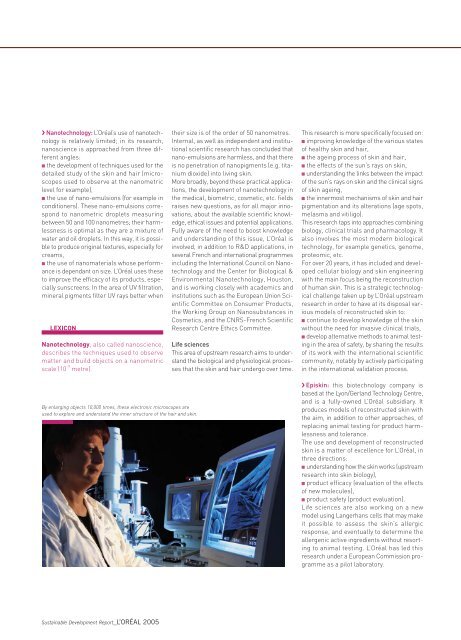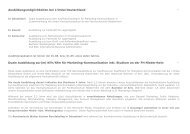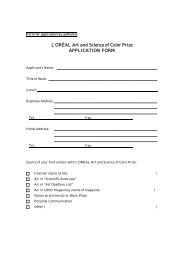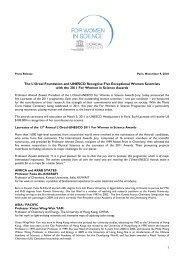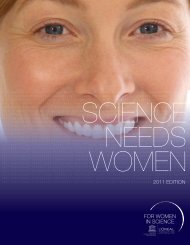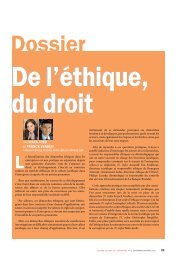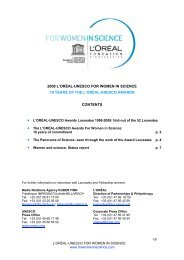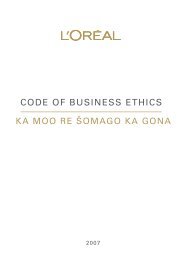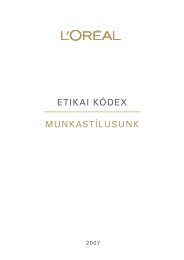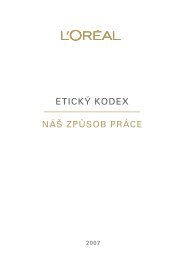2005 SUSTAINABLE DEVELOPMENT REPORT
2005 SUSTAINABLE DEVELOPMENT REPORT
2005 SUSTAINABLE DEVELOPMENT REPORT
Create successful ePaper yourself
Turn your PDF publications into a flip-book with our unique Google optimized e-Paper software.
❯ Nanotechnology: L’Oréal’s use of nanotechnology<br />
is relatively limited; in its research,<br />
nanoscience is approached from three different<br />
angles:<br />
■ the development of techniques used for the<br />
detailed study of the skin and hair (microscopes<br />
used to observe at the nanometric<br />
level for example),<br />
■ the use of nano-emulsions (for example in<br />
conditioners). These nano-emulsions correspond<br />
to nanometric droplets measuring<br />
between 50 and 100 nanometres; their harmlessness<br />
is optimal as they are a mixture of<br />
water and oil droplets. In this way, it is possible<br />
to produce original textures, especially for<br />
creams,<br />
■ the use of nanomaterials whose performance<br />
is dependant on size. L’Oréal uses these<br />
to improve the efficacy of its products, especially<br />
sunscreens. In the area of UV filtration,<br />
mineral pigments filter UV rays better when<br />
LEXICON<br />
Nanotechnology, also called nanoscience,<br />
describes the techniques used to observe<br />
matter and build objects on a nanometric<br />
scale (10 -9 metre).<br />
By enlarging objects 10,000 times, these electronic microscopes are<br />
used to explore and understand the inner structure of the hair and skin.<br />
Sustainable Development Report_L’ORÉAL <strong>2005</strong><br />
their size is of the order of 50 nanometres.<br />
Internal, as well as independent and institutional<br />
scientific research has concluded that<br />
nano-emulsions are harmless, and that there<br />
is no penetration of nanopigments (e.g. titanium<br />
dioxide) into living skin.<br />
More broadly, beyond these practical applications,<br />
the development of nanotechnology in<br />
the medical, biometric, cosmetic, etc. fields<br />
raises new questions, as for all major innovations,<br />
about the available scientific knowledge,<br />
ethical issues and potential applications.<br />
Fully aware of the need to boost knowledge<br />
and understanding of this issue, L’Oréal is<br />
involved, in addition to R&D applications, in<br />
several French and international programmes<br />
including the International Council on Nanotechnology<br />
and the Center for Biological &<br />
Environmental Nanotechnology, Houston,<br />
and is working closely with academics and<br />
institutions such as the European Union Scientific<br />
Committee on Consumer Products,<br />
the Working Group on Nanosubstances in<br />
Cosmetics, and the CNRS-French Scientific<br />
Research Centre Ethics Committee.<br />
Life sciences<br />
This area of upstream research aims to understand<br />
the biological and physiological processes<br />
that the skin and hair undergo over time.<br />
This research is more specifically focused on:<br />
■ improving knowledge of the various states<br />
of healthy skin and hair,<br />
■ the ageing process of skin and hair,<br />
■ the effects of the sun’s rays on skin,<br />
■ understanding the links between the impact<br />
of the sun’s rays on skin and the clinical signs<br />
of skin ageing,<br />
■ the innermost mechanisms of skin and hair<br />
pigmentation and its alterations (age spots,<br />
melasma and vitiligo).<br />
This research taps into approaches combining<br />
biology, clinical trials and pharmacology. It<br />
also involves the most modern biological<br />
technology, for example genetics, genome,<br />
proteomic, etc.<br />
For over 20 years, it has included and developed<br />
cellular biology and skin engineering<br />
with the main focus being the reconstruction<br />
of human skin. This is a strategic technological<br />
challenge taken up by L’Oréal upstream<br />
research in order to have at its disposal various<br />
models of reconstructed skin to:<br />
■ continue to develop knowledge of the skin<br />
without the need for invasive clinical trials,<br />
■ develop alternative methods to animal testing<br />
in the area of safety, by sharing the results<br />
of its work with the international scientific<br />
community, notably by actively participating<br />
in the international validation process.<br />
❯ Episkin: this biotechnology company is<br />
based at the Lyon/Gerland Technology Centre,<br />
and is a fully-owned L’Oréal subsidiary. It<br />
produces models of reconstructed skin with<br />
the aim, in addition to other approaches, of<br />
replacing animal testing for product harmlessness<br />
and tolerance.<br />
The use and development of reconstructed<br />
skin is a matter of excellence for L’Oréal, in<br />
three directions:<br />
■ understanding how the skin works (upstream<br />
research into skin biology),<br />
■ product efficacy (evaluation of the effects<br />
of new molecules),<br />
■ product safety (product evaluation).<br />
Life sciences are also working on a new<br />
model using Langerhans cells that may make<br />
it possible to assess the skin’s allergic<br />
response, and eventually to determine the<br />
allergenic active ingredients without resorting<br />
to animal testing. L’Oréal has led this<br />
research under a European Commission programme<br />
as a pilot laboratory.


